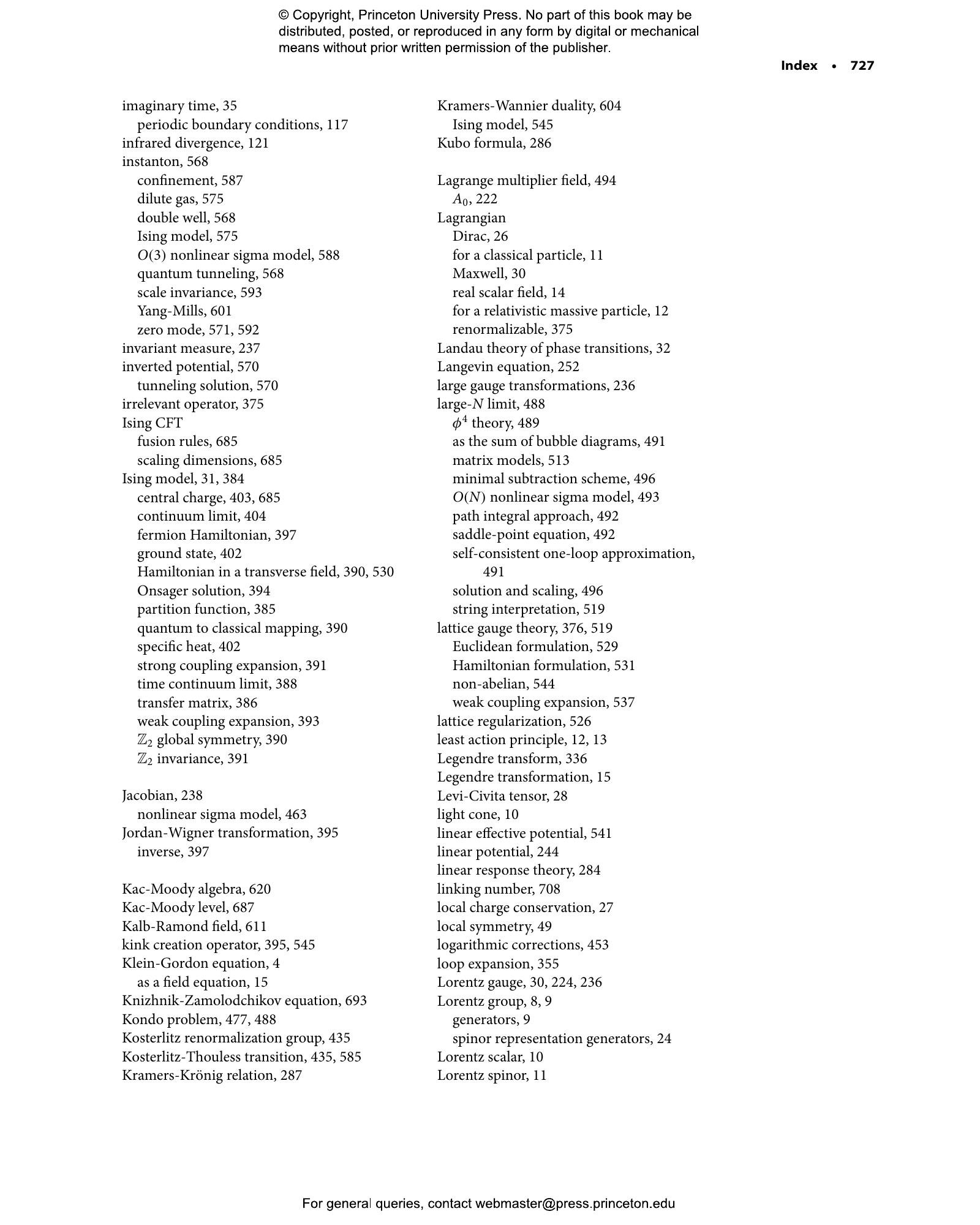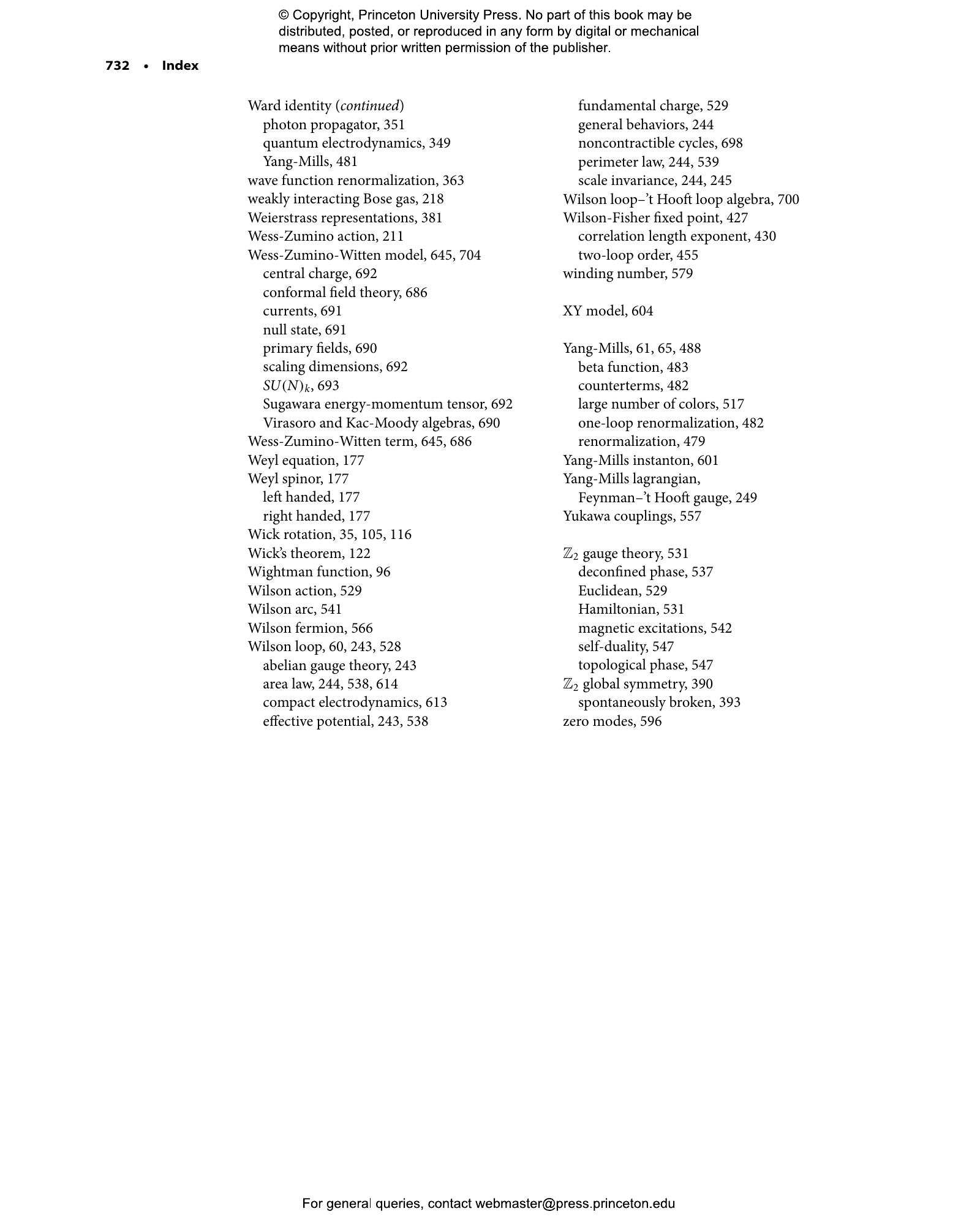Quantum field theory was originally developed to describe quantum electrodynamics and other fundamental problems in high-energy physics, but today has become an invaluable conceptual and mathematical framework for addressing problems across physics, including in condensed-matter and statistical physics. With this expansion of applications has come a new and deeper understanding of quantum field theory—yet this perspective is still rarely reflected in teaching and textbooks on the subject. Developed from a year-long graduate course Eduardo Fradkin has taught for years to students of high-energy, condensed-matter, and statistical physics, this comprehensive textbook provides a fully “multicultural” approach to quantum field theory, covering the full breadth of its applications in one volume.
- Brings together perspectives from high-energy, condensed-matter, and statistical physics in both the main text and exercises
- Takes students from basic techniques to the frontiers of physics
- Pays special attention to the relation between measurements and propagators and the computation of cross sections and response functions
- Focuses on renormalization and the renormalization group, with an emphasis on fixed points, scale invariance, and their role in quantum field theory and phase transitions
- Other topics include non-perturbative phenomena, anomalies, and conformal invariance
- Features numerous examples and extensive problem sets
- Also serves as an invaluable resource for researchers
Eduardo Fradkin is the Donald Biggar Willett Professor of Physics at the University of Illinois, Urbana-Champaign. An internationally recognized leader in theoretical physics and a member of the National Academy of Sciences, he is the author of Field Theories of Condensed Matter Physics.
- Preface and Acknowledgments
- 1 Introduction to Field Theory
- 1.1 Examples of fields in physics
- 1.2 Why quantum field theory?
- 2 Classical Field Theory
- 2.1 Relativistic invariance
- 2.2 The Lagrangian, the action, and the least action principle
- 2.3 Scalar field theory
- 2.4 Classical field theory in the canonical formalism
- 2.5 Field theory of the Dirac equation
- 2.6 Classical electromagnetism as a field theory
- 2.7 The Landau theory of phase transitions as a field theory
- 2.8 Field theory and statistical mechanics
- Exercises
- 3 Classical Symmetries and Conservation Laws
- 3.1 Continuous symmetries and Noether’s theorem
- 3.2 Internal symmetries
- 3.3 Global symmetries and group representations
- 3.4 Global and local symmetries: Gauge invariance
- 3.5 The Aharonov-Bohm effect
- 3.6 Non-abelian gauge invariance
- 3.7 Gauge invariance and minimal coupling
- 3.8 Spacetime symmetries and the energy-momentum tensor
- 3.9 The energy-momentum tensor for the electromagnetic field
- 3.10 The energy-momentum tensor and changes in the geometry
- Exercises
- 4 Canonical Quantization
- 4.1 Elementary quantum mechanics
- 4.2 Canonical quantization in field theory
- 4.3 Quantization of the free scalar field theory
- 4.4 Symmetries of the quantum theory
- Exercises
- 5 Path Integrals in Quantum Mechanics and Quantum Field Theory
- 5.1 Path integrals and quantum mechanics
- 5.2 Evaluating path integrals in quantum mechanics
- 5.3 Path integrals for a scalar field theory
- 5.4 Path integrals and propagators
- 5.5 Path integrals in Euclidean spacetime and statistical physics
- 5.6 Path integrals for the free scalar field
- 5.7 Exponential decays and mass gaps
- 5.8 Scalar fields at finite temperature
- Exercises
- 6 Nonrelativistic Field Theory
- 6.1 Second quantization and the many-body problem
- 6.2 Nonrelativistic field theory and second quantization
- 6.3 Nonrelativistic fermions at zero temperature
- Exercises
- 7 Quantization of the Free Dirac Field
- 7.1 The Dirac equation and quantum field theory
- 7.2 The propagator of the Dirac spinor field
- 7.3 Discrete symmetries of the Dirac theory
- 7.4 Chiral symmetry
- 7.5 Massless fermions
- Exercises
- 8 Coherent-State Path-Integral Quantization of Quantum Field Theory
- 8.1 Coherent states and path-integral quantization
- 8.2 Coherent states
- 8.3 Path integrals and coherent states
- 8.4 Path integral for a nonrelativistic Bose gas
- 8.5 Fermion coherent states
- 8.6 Path integrals for fermions
- 8.7 Path-integral quantization of the Dirac field
- 8.8 Functional determinants
- 8.9 The determinant of the Euclidean Klein-Gordon operator
- 8.10 Path integral for spin
- Exercises
- 9 Quantization of Gauge Fields
- 9.1 Canonical quantization of the free electromagnetic field
- 9.2 Coulomb gauge
- 9.3 The gauge A0 = 0
- 9.4 Path-integral quantization of gauge theories
- 9.5 Path integrals and gauge fixing
- 9.6 The propagator
- 9.7 Physical meaning of Z[J] and the Wilson loop operator
- 9.8 Path-integral quantization of non-abelian gauge theories
- 9.9 BRST invariance
- Exercises
- 10 Observables and Propagators
- 10.1 The propagator in classical electrodynamics
- 10.2 The propagator in nonrelativistic quantum mechanics
- 10.3 Analytic properties of the propagators of free relativistic fields
- 10.4 The propagator of the nonrelativistic electron gas
- 10.5 The scattering matrix
- 10.6 Physical information contained in the S-matrix
- 10.7 Asymptotic states and the analytic properties of the propagator
- 10.8 The S-matrix and the expectation value of time-ordered products
- 10.9 Linear response theory
- 10.10 The Kubo formula and the electrical conductivity of a metal
- 10.11 Correlation functions and conservation laws
- 10.12 The Dirac propagator in a background electromagnetic field
- Exercises
- 11 Perturbation Theory and Feynman Diagrams
- 11.1 The generating functional in perturbation theory
- 11.2 Perturbative expansion for the two-point function
- 11.3 Cancellation of the vacuum diagrams
- 11.4 Summary of Feynman rules for ϕ4 theory
- 11.5 Feynman rules for theories with fermions and gauge fields
- 11.6 The two-point function and the self-energy in ϕ4 theory
- 11.7 The four-point function and the effective coupling constant
- 11.8 One-loop integrals
- Exercises
- 12 Vertex Functions, the Effective Potential, and Symmetry Breaking
- 12.1 Connected, disconnected, and irreducible propagators
- 12.2 Vertex functions
- 12.3 The effective potential and spontaneous symmetry breaking
- 12.4 Ward identities
- 12.5 The low-energy effective action and the nonlinear sigma model
- 12.6 Ward identities, Schwinger-Dyson equations, and gauge invariance
- Exercises
- 13 Perturbation Theory, Regularization, and Renormalization
- 13.1 The loop expansion
- 13.2 Perturbative renormalization to two-loop order
- 13.3 Subtractions, counterterms, and renormalized Lagrangians
- 13.4 Dimensional analysis and perturbative renormalizability
- 13.5 Criterion for perturbative renormalizability
- 13.6 Regularization
- 13.7 Computation of regularized Feynman diagrams
- 13.8 Computation of Feynman diagrams with dimensional regularization
- Exercises
- 14 Quantum Field Theory and Statistical Mechanics
- 14.1 The classical Ising model as a path integral
- 14.2 The transfer matrix
- 14.3 Reflection positivity
- 14.4 The Ising model in the limit of extreme spatial anisotropy
- 14.5 Symmetries and symmetry breaking
- 14.6 Solution of the two-dimensional Ising model
- 14.7 Continuum limit and the two-dimensional Ising universality class
- Exercises
- 15 The Renormalization Group
- 15.1 Scale dependence in quantum field theory and in statistical physics
- 15.2 RG flows, fixed points, and universality
- 15.3 General properties of a fixed-point theory
- 15.4 The operator product expansion
- 15.5 Simple examples of fixed points
- 15.6 Perturbing a fixed-point theory
- 15.7 Example of operator product expansions: ϕ4 theory
- Exercises
- 16 The Perturbative Renormalization Group
- 16.1 The perturbative renormalization group
- 16.2 Perturbative renormalization group for the massless ϕ4 theory
- 16.3 Dimensional regularization with minimal subtraction
- 16.4 The nonlinear sigma model in two dimensions
- 16.5 Generalizations of the nonlinear sigma model
- 16.6 The O(N) nonlinear sigma model in perturbation theory
- 16.7 Renormalizability of the two-dimensional nonlinear sigma model
- 16.8 Renormalization of Yang-Mills gauge theories in four dimensions
- Exercises
- 17 The 1/N Expansions
- 17.1 The ϕ4 scalar field theory with O(N) global symmetry
- 17.2 The large-N limit of the O(N) nonlinear sigma model
- 17.3 The CPN−1 model
- 17.4 The Gross-Neveu model in the large-N limit
- 17.5 Quantum electrodynamics in the limit of large numbers of flavors
- 17.6 Matrix sigma models in the large-rank limit
- 17.7 Yang-Mills gauge theory with a large number of colors
- Exercises
- 18 Phases of Gauge Theories
- 18.1 Lattice regularization of quantum field theory
- 18.2 Matter fields
- 18.3 Minimal coupling
- 18.4 Gauge fields
- 18.5 Hamiltonian theory
- 18.6 Elitzur’s theorem and the physical observables of a gauge theory
- 18.7 Phases of gauge theories
- 18.8 Hamiltonian duality
- 18.9 Confinement in the Euclidean spacetime lattice picture
- 18.10 Behavior of gauge theories coupled to matter fields
- 18.11 The Higgs mechanism
- 18.12 Phase diagrams of gauge-matter theories
- Exercises
- 19 Instantons and Solitons
- 19.1 Instantons in quantum mechanics and tunneling
- 19.2 Solitons in (1+1)-dimensional ϕ4 theory
- 19.3 Vortices
- 19.4 Instantons and solitons of nonlinear sigma models
- 19.5 Coset nonlinear sigma models
- 19.6 The CPN−1 instanton
- 19.7 The ’t Hooft–Polyakov magnetic monopole
- 19.8 The Yang-Mills instanton in D = 4 dimensions
- 19.9 Vortices and the Kosterlitz-Thouless transition
- 19.10 Monopoles and confinement in compact electrodynamics
- Exercises
- 20 Anomalies in Quantum Field Theory
- 20.1 The chiral anomaly
- 20.2 The chiral anomaly in 1+1 dimensions
- 20.3 The chiral anomaly and abelian bosonization
- 20.4 Solitons and fractional charge
- 20.5 The axial anomaly in 3+1 dimensions
- 20.6 Fermion path integrals, the chiral anomaly, and the index theorem
- 20.7 The parity anomaly and Chern-Simons gauge theory
- 20.8 Anomaly inflow
- 20.9 θ vacua
- Exercises
- 21 Conformal Field Theory
- 21.1 Scale and conformal invariance in field theory
- 21.2 The conformal group in D dimensions
- 21.3 The energy-momentum tensor and conformal invariance
- 21.4 General consequences of conformal invariance
- 21.5 Conformal field theory in two dimensions
- 21.6 Examples of two-dimensional CFTs
- Exercises
- 22 Topological Field Theory
- 22.1 What is a topological field theory?
- 22.2 Deconfined phases of discrete gauge theories
- 22.3 Chern-Simons gauge theories
- 22.4 Quantization of abelian Chern-Simons gauge theory
- 22.5 Vacuum degeneracy on a torus
- 22.6 Fractional statistics
- Exercises
- References
- Index
"A very modern presentation of quantum field theory integrating applications to condensed-matter and high-energy particle physics. Fradkin's approach both clarifies conceptual issues, such as the renormalization procedure, and presents many contacts with experiments."—Juan Maldacena, Institute for Advanced Study in Princeton
"This superb textbook combines mathematical accuracy with keen physical intuition and a style that is precise yet friendly and easy to read. With his deep grasp of both condensed-matter physics and elementary-particle physics, Fradkin presents quantum field theory as a versatile and multifaceted tool to explore a wide range of physical phenomena."—Natan Andrei, Rutgers University
"Fradkin connects the areas of high-energy and condensed-matter physics through the common language of quantum field theory. I do not know of another introductory text that does this so well."—Frank Petriello, Northwestern University
"Fradkin has a deep understanding of a broad range of issues in quantum field theory, and he moves smoothly between particle physics and viewpoints in condensed matter and statistical mechanics. This exceptional book will be of great value to the theoretical physics community."—Michael Dine, author of Supersymmetry and String Theory: Beyond the Standard Model




























